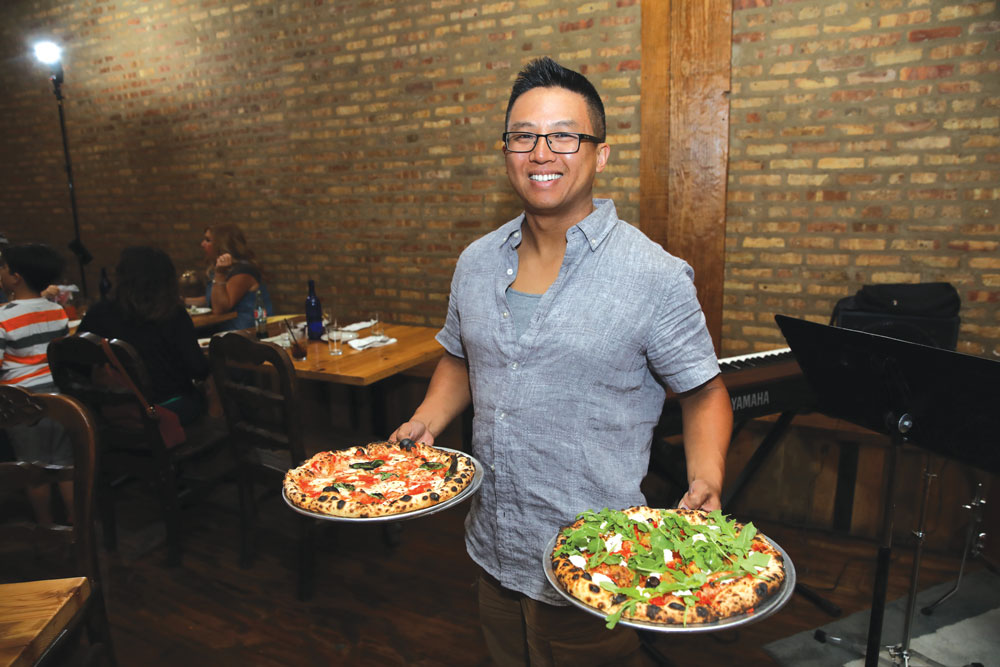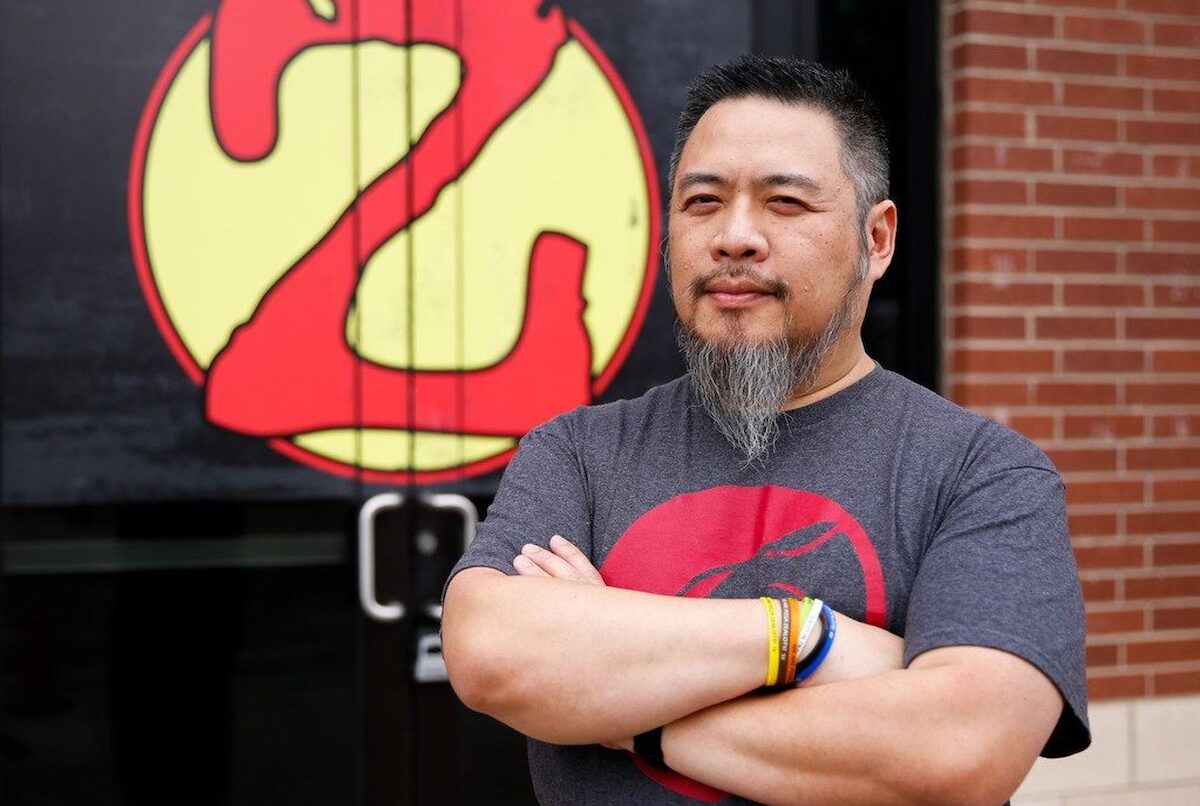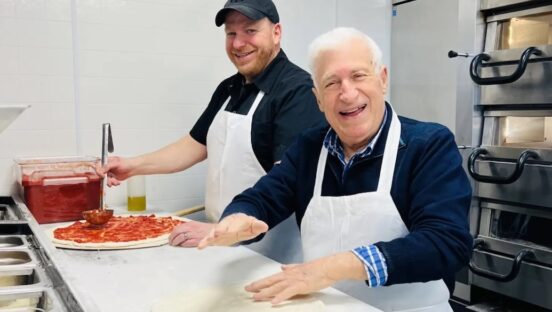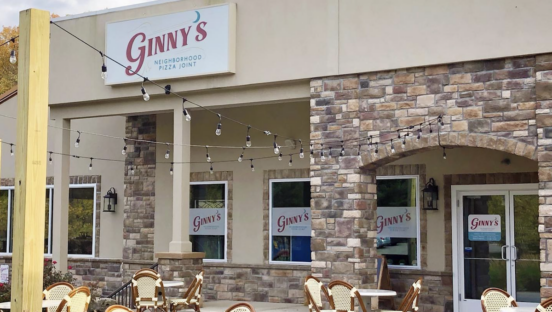Paulie Giannone was a middle-aged, ex-IT professional when he started Paulie Gee’s in Brooklyn’s Green Point neighborhood in 2010. The concept quickly found success and expanded to Miami, Baltimore and Columbus, Ohio. When the native New Yorker was ready to move into that other pizza capital, he tapped another reformed office drone for the job—lifelong Chicagoan Derrick Tung, a former healthcare-administrator-turned-pizzaiolo and the former operator of the wood-fired mobile pizza operation Za Pi. Tung opened Paulie Gee’s Logan Square in the summer of 2016. In this interview, Tung, respected as much for his keen business mind as his pizza making chops, tackles the thorny subject of paying and retaining good employees, solving the disparity between back-of-house and front-of-house compensation—and why his opening night was such a stinker.
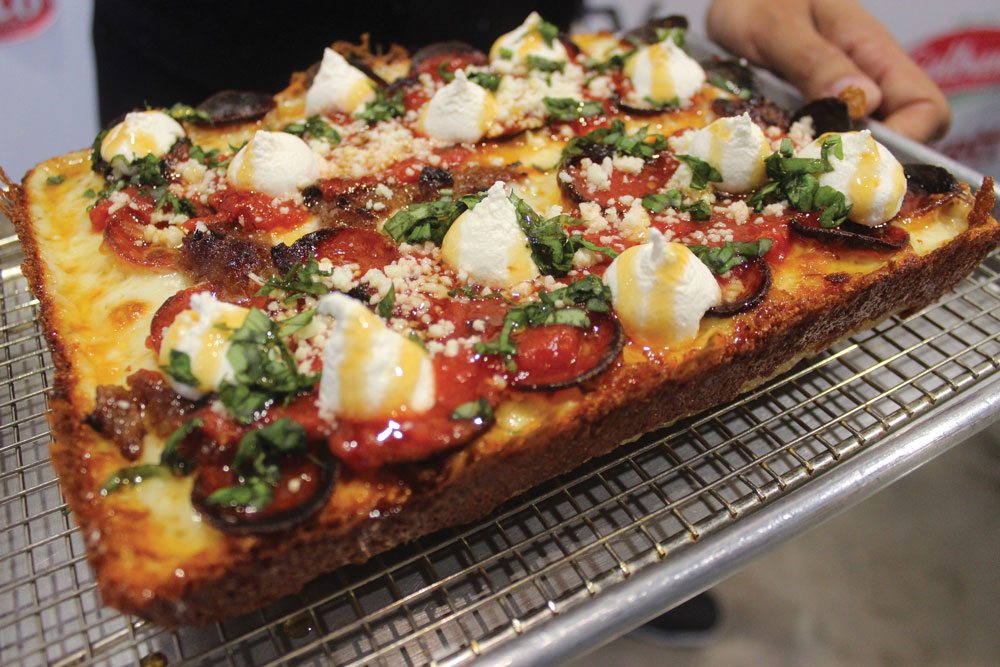 |
|
Derrick Tung won the Gluten-Free category of last year’s U.S. Pizza Cup with this Detroit-style beauty. Made with gluten-free flour, it featured mozzarella, sharp white cheddar, pepperoni, bacon jam, ricotta, and Mike’s Hot Honey. |
— Derrick Tung
 |
|
Located in Chicago’s Logan Square neighborhood, Paulie Gee’s Logan Square is a 75-seat restaurant with a full bar area that provides seating for an additional 20 guests. |
Porter: Why did you decide to partner with Paulie instead of opening your own place?
Tung: Partnering with Paulie provided me with the confidence to open up a larger spot from the get-go. He provided strong mentorship around many of the questions I had for my first restaurant, along with teaching me more about his wood-fired pizza processes. When we first opened, about one out of every three guests were either New York transplants, had been to Paulie’s in Brooklyn, or had heard of Paulie Gee’s. That was a significant amount. Also, the mention of Paulie Gee’s in Chicago was able to draw some great press around our opening, which helped put our restaurant on the radar faster. Paulie and I share a lot of similar views when it comes to business, which made for a good fit as a mentor/mentee relationship. While we don’t agree on everything, we often can agree to disagree and move on, which is important in any relationship.
AUDIO: Click here to listen to the entire interview with Derrick Tung of Paulie Gee’s Logan Square!
Porter: I hear there was an opening-night horror story. Can you tell us more about it?
Tung: We decided to open on a Thursday night so that we could ease into the weekend and make adjustments as necessary. We opened our doors, and the house was pretty much full within the first hour, and we were buzzing along. About an hour and a half in, one of my staff members tells me there’s water coming up from the ground in our dish room. By the time I got back there, they were already trying to use physical obstacles to block it off so the rising water wouldn’t flow into the back kitchen area. While I’m assessing the dish room, someone comes to tell me that the [customer] bathrooms are also starting to see water coming up from the pipes. At this point, we ended up comping all the food and drinks for the guests that were in-house. We shut down operations and deep-cleaned everything the water touched, since we suspected it was sewage water.
We all went home, pretty deflated after weeks of ramping up for our big open. When I’m upset, I eat Totino’s Pizza Rolls and drink root beer floats. The next day, we let everyone know that opening time has been delayed due to city construction problems. We investigate the issue all day, and we stress-test the system by running water for four hours and flushing the toilets regularly to see if there’s still a backup issue. About one hour before we open, we see the rising waters again and have to shut down again, but at least this time there were no guests to kick out.
Finally, after a full morning of fixing some of the issues and stress-testing the system for eight hours—which produced an insane water bill—we opened our doors again on Saturday, July 9. In Chinese culture, water represents good fortune, so my parents firmly believed this was a good omen for the restaurant. But I don’t think the omen accounts for sewage water.
| Detroit Meets Chicago—Minus the Gluten |
| Derrick Tung, owner of Paulie Gee’s Logan Square in Chicago, was disappointed with his first pizza competition experience and wasn’t planning to try again. It’s a good thing he changed his mind: His entry in the Gluten-Free category of the U.S. Pizza Cup, held last June at the North American Pizza & Culinary Academy in Chicago, helped catapult Tung to pizza making glory. His Detroit-style pie featured a 100% starter made with gluten-free flour and a 24-hour rise time before par-baking. He topped it with whole-milk, low-moisture mozzarella, a sharp white cheddar edge, two layers of cupped pepperoni (under and over the cheese), and a housemade bacon jam, then finished it with post-oven ricotta and a drizzle of Mike’s Hot Honey. The win earned him a spot on the U.S. Pizza Team and a chance to compete in this year’s World Pizza Championship in Parma, Italy. |
Porter: What are the similarities and differences between the various Paulie Gee’s locations?
Tung: All the locations offer wood-fired pizza that has nearly the exact same dough recipe at each location. We’re all playing Paulie’s greatest hits, so pizzas like the Hellboy, Cherry Jones, Greenpointer and others are ones that we want everyone to experience. But from there, each location definitely has its own persona. The salads, desserts and many of the pizzas reflect a lot of what each owner feels is best for their community, along with their personal interests.
For instance, I’ve always loved kimchi on pizza, so we make a housemade kimchi and top it on our pizzas, as inspired by my wife’s favorite pizzeria in the world, Pizzeria Lola in Minneapolis. Growing up, I’ve always loved the all-meat pizza from Pizza Hut, so the Big Bad Wolf was an ode to the all-meat pizzas I remember—but dressed up using sopressata, local Italian fennel sausage, and housemade bacon jam. The biggest difference at Paulie Gee’s Logan Square is the Detroit-inspired pizza that we offer, which has become our top-selling pizza. After a side trip to Detroit with my wife before the restaurant opened, we fell in love at first bite with Buddy’s Pizza. I came home and started researching and learning how to make my own version of what I remembered from that one experience, which resulted in the Logan Square pie that you can get at my restaurant. I’ve had a chance to go back to Detroit and try eight different Detroit-style pizza restaurants, and it made me realize that my memory of the Buddy’s pie is very different from what we’re executing now. I still love Buddy’s plenty, but it’s definitely not the same pie.
— Derrick Tung
Porter: How do you decide what to feature for your Square of the Month special?
Tung: Each month, my staff and I rotate one wood-fired pizza and two Logan Squares—our Herbivore and Omnivore. What we pick is somewhat random. Sometimes it’s about seasonality of ingredients, while other times it’s a food we tried somewhere and wanted to reimagine on a pizza, like Italian beef or lasagna. Sometimes it’s just a whim that we want to play with, like lighting a pizza on fire tableside with a saganaki-style pie. We typically will taste a pizza at least four or five times before it makes the menu, tweaking different aspects of it. We focus on a variety of taste factors, including saltiness, acidity, sweetness and textures, so we’re often making additional adjustments before the final pizzas of the month are introduced.
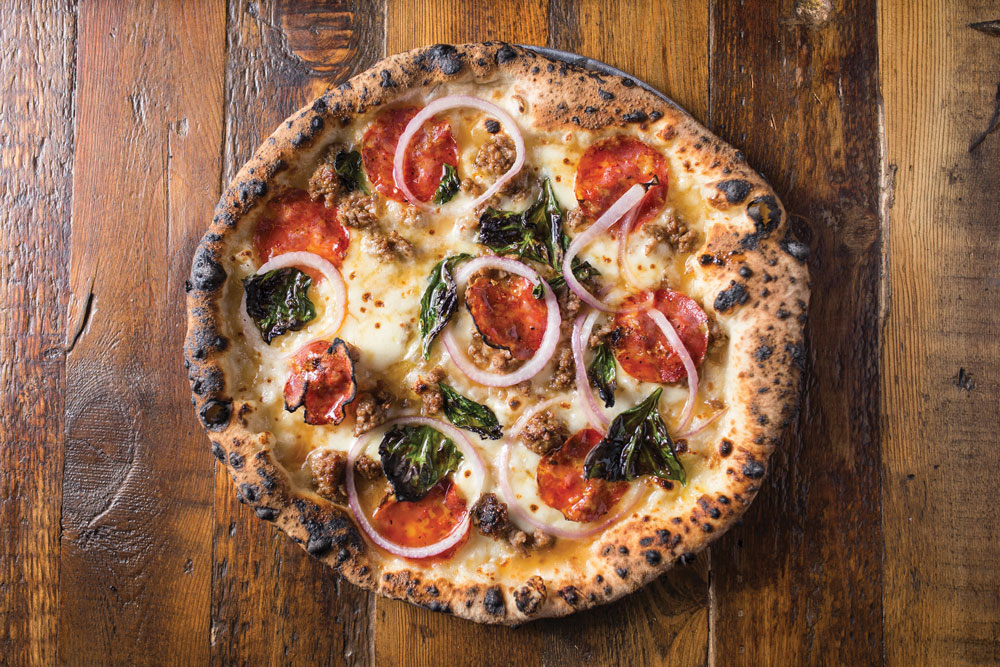 |
|
A popular Paulie Gee’s standard, the Hellified Pork Pie White comes with fresh mozz, Berkshire sopressata picante, sweet Italian fennel sausage, sliced red onions, sliced fresh garlic, fresh basil and Mike’s Hot Honey. |
Porter: Can you talk a little bit about how you incentivize and reward your staff, and why that’s important?
Tung: I’m a firm believer that, for staff to be motivated, rewards must be aligned properly with goals. We use a lot of different methods for rewarding and celebrating with staff, ranging from celebration meals when we break old records to staff outings about once every six months. It’s important to spend time together as a team outside of the restaurant so that we get to know each other as family.
One of the key things I’ve always disliked is that, at most restaurants, only the front-of-house staff reaps the rewards of a busy night based on tips, while the back-of-house works harder but with no reward. Whenever I worked back-of-house at some places, it was one of my biggest annoyances that there was no reward for busier nights versus slower ones. To address this problem, I adopted one of the systems that Paulie uses to reward his pizza line. Our pizza makers have a base hourly rate, and once we hit a certain nightly sales target, they begin earning a bonus per hour based on house sales. For instance, our first-tier target right now is $2,500, so any time we hit that, the pizza makers make an additional $1 per hour for that shift. For every $1,000 more we hit, they make another $1 per hour. So, at $5,500, each pizza maker is making an additional $4 per hour. This doesn’t balance out the difference in front-of-house versus back-of-house pay, but it helps keep our team focused as we get busier and gives them something to be excited about as each order comes in.
Also, with the recent changes in federal law regarding tip sharing, we’ll be testing out a new system that will help close the gap a bit more and align everyone onto a tip structure that will help incentivize everybody a little more tightly.
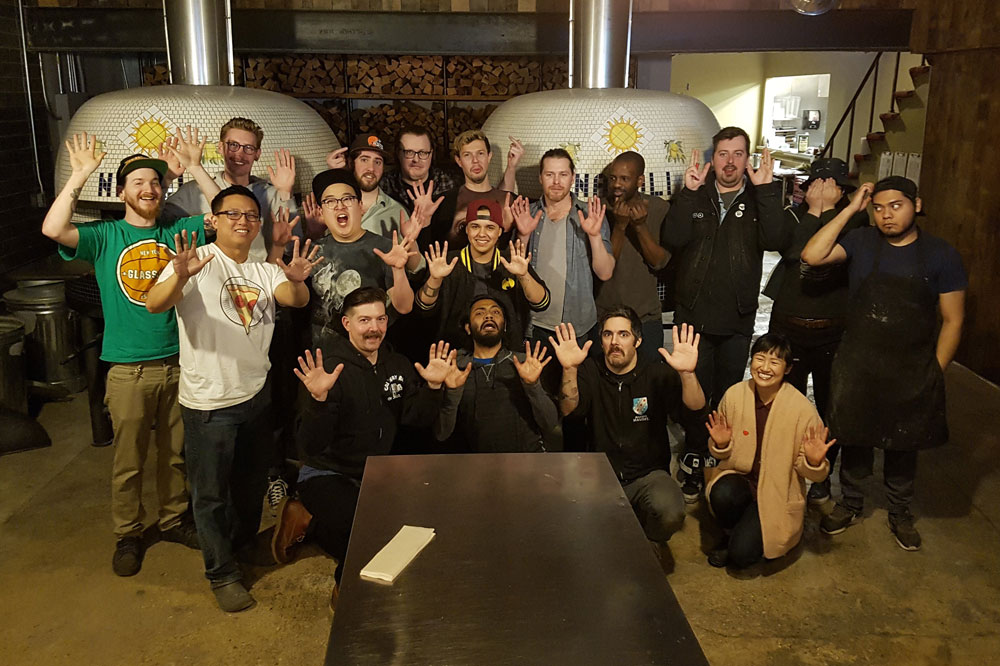 |
|
Tung recognizes the value of both his front-of-house and back-of-house staff and works to pay everyone equitably. |
Porter: How did you determine that things were out of balance in terms of compensation for FOH and BOH?
Tung: We experienced some great growth in 2018, so I wanted to see what the impact was across everyone’s hourly and total pay—mostly focused on the hourly. In January 2018, the difference in a FOH position’s pay vs. BOH was significant ($27 an hour vs. $12.12 an hour). By November 2018, FOH saw a 27.7% increase in hourly pay, while BOH saw a 12.5% increase due to higher volume at the restaurant. This was solely based on tips (FOH) and bonuses (BOH), which just helped reinforce to me how unaligned this system is. As we continue to grow, this system would basically have our FOH continue to make more via tips (volume), but BOH would continue to increase at a slower rate (under the current bonus structure). I want our system to reflect the importance of BOH, so I felt like we had to revise our whole payment system.
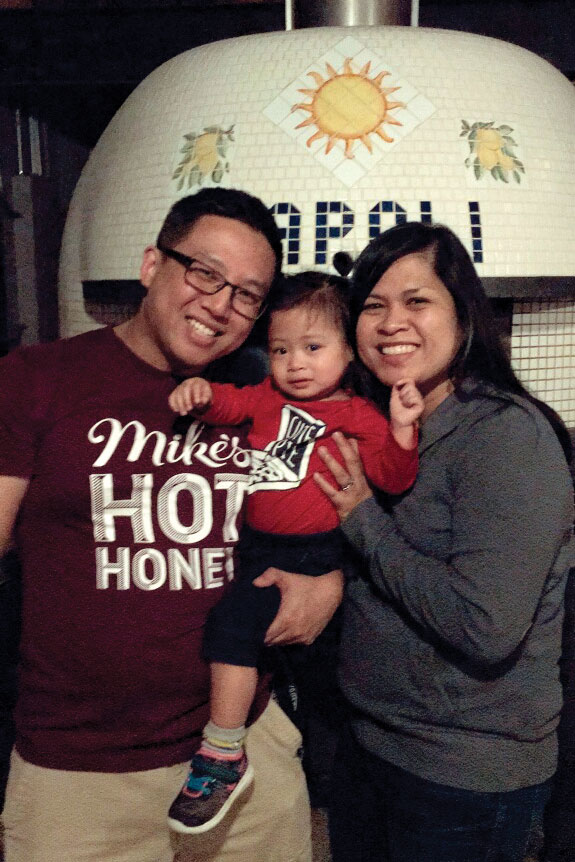 |
|
Shown here with his wife, Cathy Reyes, and daughter Abby, Tung often posts pics of his family on the pizzeria’s social media platforms. |
Porter: How does the new structure work?
Tung: It has four key components: tips, loyalty-based pay, skill-based pay, and intangibles. As you may know, the new federal law allows for restaurants to spread tips throughout the house (with owners/managers excluded) but first requires that all folks are making the minimum untipped wage per hour as mandated by federal and local laws—whichever is higher. In Chicago, that means $12 an hour for now and $13 an hour in July. So, to do this, it requires us to pay our servers, bartenders, hosts, etc. that minimum wage. This comes out to around $5,000 extra per month, which would equate to about 22% of tips. This 22% will be spread across the BOH based on hours worked and positions being covered. And for the company to cover that $5,000 per month, we discussed new lines of potential revenue at our staff meeting, where they generated many ideas that we plan to start trying to implement in March 2019. These include semi-private chef’s table experiences, private pizza making lessons, cost-cutting strategies, price increases on our most popular items, etc.
When I was asking around as to whether anyone was doing this already, some folks suggested just raising wages for BOH directly. That’s always an option, but it doesn’t put everyone on the same plane of incentivization. The goal is to have a system where everyone—from the host to the server to the pizza maker to the dishwasher—is excited that we have another guest walking through our doors because that extra guest doesn’t just mean the company will do better—it means they’ll do financially better too, which I hope will lead to a better experience for all our staff and our guests.
While revising the system, I began exploring how other companies paid their employees, and the Costco employee payment model stuck out particularly. They utilize a system where, for every 1,040 hours you work (half a year for a full-time employee), you receive a raise ranging from 25 cents up to $1 (around year four). This system makes sense, especially for the restaurant industry, where turnover rates are high and employees are always looking for more money. Given the time and money cost of training staff, I felt this system would be good to model after. The more time someone spends in the restaurant working, typically, the more valuable they are, as they’ve built the experience of knowing what to do in different situations for their position. This loyalty-based method of pay seemed like a great basis for the new payment structure.
Porter: What about pay based on skills and intangibles?
Tung: The current vision is to have a skills test tied to each level of loyalty raises. So, for example, I would want a newer server who’s put in 1,040 hours with us to know our top three selling pizzas based on guest orders so they can provide advice to new guests. They also need to know our top five highest-margin items to help boost our bottom line. For a pizza maker, I would want them to be able to stretch four pizza doughs in a certain amount of time to keep pace on busy nights. We’re still looking at the system to determine how the skills tests and loyalty hours should tie together for our base wage system.
Finally, we have a set of intangibles that we’d like to take into consideration for moving to the next tier. Things like how often they smile, how well they play with the rest of the team, their willingness to pick up shifts when we need help—things that we don’t have an easy way to benchmark/measure but are important to a well-functioning team. I’m still looking at ways to measure this so that it’s more factual and not so experientially based when we have discussions with staff on improvement. If anyone has any advice on this part, let me know!
Porter: So what’s next for your restaurant?
Tung: I want to continue to optimize the space for more service. For instance, we recently opened up on Tuesday evenings and started having a limited lunch service on Saturdays and Sundays. As the area grows and as guests ask for it, we hope to grow into a brunch on weekends and have lunch available during weekdays when it makes sense. We’re also working on creating a program where guests can come in and learn how to make pizzas and potentially other fun, unique experiences for our guests. I’ve always toyed with the idea of offering another style of pizza as well, but that’s on the back burner for now, potentially further down the line!
Jonathan Porter is the owner of Chicago Pizza Tours and a frequent contributor to PMQ.



